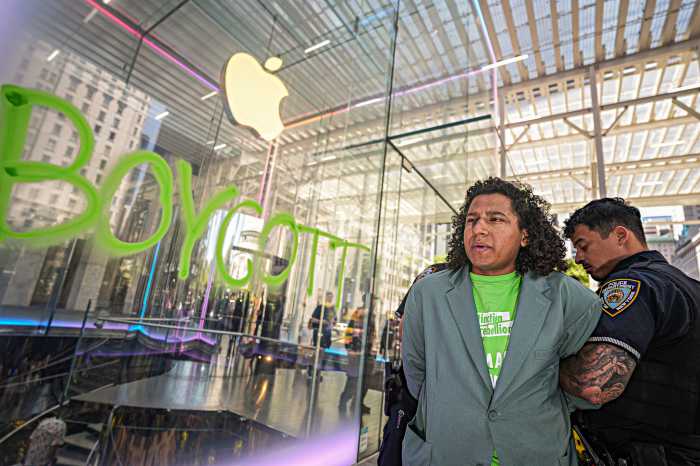
There is no snooze button at the Somerfeld household on the Upper East Side of Manhattan. While Lance Somerfeld puts a pink tank top and matching skirt on his daughter Jade, 4, his wife, Jessica, is buttoning her suit and heading out the door for work.
The Somerfelds are not an anomaly. More American dads than ever — double in the last decade — have taken on the challenge of full-time parenting, according to the Pew Research Center.
“Dads should definitely do it because it is awesome. You get to bond with your kid,” said Daniel Svanberg, writer and stay-at-home father to Mina, 15 months. “You just get to discover this little person, and see them grow up. it’s amazing.”
In 2016, dads were nearly one out of five stay-at-home parents in the U.S., according to Pew. While rising childcare costs and women out-earning their spouses are big factors, many dads are at home because they want to be.

The increase of stay-at-home dads coincided with the doubling of the number of college-educated women, according to the U.S. Bureau of Labor & Statistics. The increase among women in higher learning is significant. Among U.S. women with bachelor’s degrees, 40 percent are in their 30s when they begin having children, according to Pew research.
“The conundrum that women have always had is that the prime years of hitting the accelerator on your career, late 20s through mid 30s, where people see a lot of gains financially and also promotions, have always coincided with a woman’s biological clock,” said Brad Harrington, executive director at the Center for Work and Family at Boston College. “That has always hurt women’s career prospects, the fact that they have an interrupted career pattern compared to men who don’t.”
Women don’t want to leave their jobs, says Harrington, when they have worked their way to a promotion to, say, vice president. As more women enter male-dominated professions that pay more than jobs that women have traditionally held, they are less likely to leave their jobs to take care of children.
“While a lot of the women at my wife’s company leave or cut back after they have children, my wife has enough experience at this point that she was promoted and given her own team,” said Xavier Rojas, former human resources specialist and father of Lilou, 2. “I am happy to be able to support her and let her excel at her job as a fashion designer which she has always been good at.”
Staying at home with a child is not always a choice, but an economic necessity. Childcare consumes, on average, one-quarter of a household’s income. Across America, the cost is nearly double the in-state public university tuition, according to Child Care Aware of America, an advocacy group. Some couples decide one parent should stay at home simply because they cannot afford childcare.

For many families, the choice to have one parent stay home isn’t merely a financial decision. Many Americans believe children are better off with a stay-at-home parent. Historically, that parent has been a woman — but that norm may be experiencing a change, in part because of the wider availability of paternal leave.
The Somerfelds felt very strongly one parent should stay at home, but they were both dedicated to their careers. Jessica Somerfeld, vice president of a Fortune 500 company, had put in long hours as an actuary.
Her husband couldn’t imagine being anything but a high school teacher until he took his parental leave allowed by his employer. Boston College family surveys have shown that allowing men equal parental leave has inspired bonding for fathers, and has even influenced some of the decisions to stay at home. Lance Somerfeld had never imagined himself as a stay-at-home parent before then. His wife was relieved when child rearing came naturally to him. She said she likes going to work every day, and then coming home to her family at the end.
“Being a stay-at-home parent is a challenge; you’re always on. You can’t take a break,” said Lance Somerfeld, founder of NYC Dads Group, a network of stay-at-home fathers. “But I can’t imagine being a teacher to anyone but my children. I know my wife loves her job and I am grateful that I can support her career, but I really am the luckier parent.”
Economists predict that as stay-at-home fathers become more visible in society, women will feel like they have choices about achieving career goals, according to a University of Arizona study. If women think more men are becoming stay-at-home dads, it is more likely they will see themselves as breadwinners.

The number of breadwinning mothers in the U.S. — almost two-thirds — has doubled over the last 30 years, according to the Center for American Progress. Almost 40 percent of married women earn more than their spouses.
“As women have been increasing their participation in the labor force and entering more occupations, so their pay rises,” said Elise Gould, senior economist at Economic Policy Institute, a think tank. “Often times you take the lower paid member of the household and they’re the ones that wind up being home. That speaks to the future labor outcomes for women.”
Research from a 2007 Columbia University study found that men who took parental leave are more likely to be involved parents even after they return to work.
Being all-hands-on-deck is intrinsic to raising Lily, 2, who has two stay-at-home dads, Scott and Jay Paranada-Fried. Jay Paranada-Fried, who goes by dad, spent the last year traveling the country with the national Broadway tour of Aladdin, while his husband, Scott, who goes by papa, cared for their daughter.
Scott and Jay Paranada-Fried trade off staying-at-home depending on Jay’s work as an actor, which is less stable than Scott’s job as a Harlem elementary school teacher in ESL. He has been on childcare leave for the past year, and can easily return to his job.

Despite the challenges, bonding with Lily is the most important thing, says Scott Paranada-Fried. They don’t want to miss a single moment in her life. They have an Instagram account for their daughter, @lilybeabea, where they have posted every single day since her birth.
“When she makes me laugh or when she makes other people laugh — just being there for that and knowing that it’s not going to last forever, but I have these moments right now,” said Scott Paranada-Fried. “We want to be there for everything she experiences.”




































